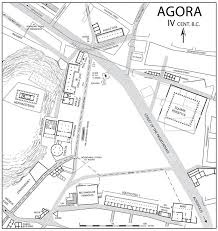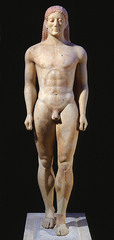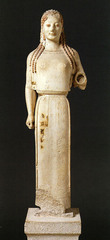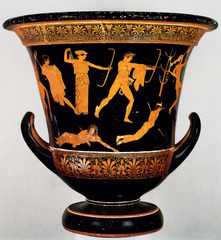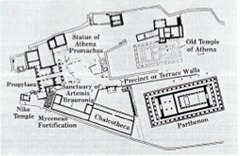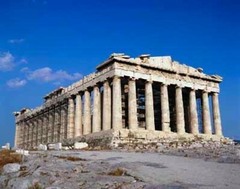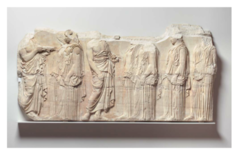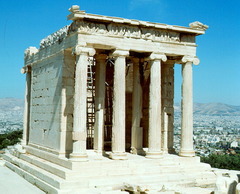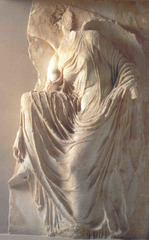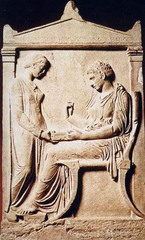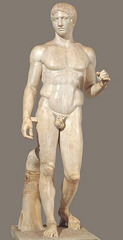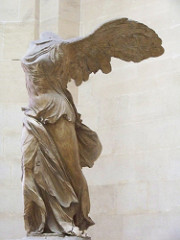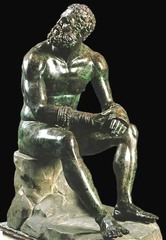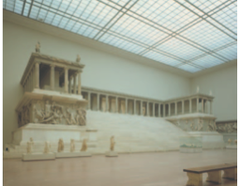Athenian Agora Plan
Per: Archaic through hellenistic greek
F: plan of early Athens, before Parthenon center of town (stores, social & political events, temples, schools) commercial, civic, religious, and social buildings
D: 600-150 BCE
A: Athenians
P: N/A
C: South Stoa: origin of the word stores, was a grouping of shops. Plaza at the base of the Acropolis in Athens. setting for the panathenaic festival, ceremonies, and parades to honor Athena. the panathenaic way cuts through the plaza from the northwest to the northeast. plaza is surrounded by important buildings including a bouleuterion(a chamber used by a council of citizens) a tholos(round temple), several stoas (a covered walkway) center of the ancient city. used for a market, election, dramatic per, religious precession, military drills, athletic comp, admin, polt, judicial, commercial, religious, cultural, etc. Architectural plan. heart of athens. remains of ionic body in the agora. temple of zeus and athena. law making body in agora. primary sacred spot.
Anavysos Kouros
A: N/A
P: family of kroisos
Per: archaic Greece
D: 530 BCE
sub: athletic young man, grave marker of war hero
form: figures are beginning to look life-like (but legs are still straight and he wears the archaic smile)
mat: marble
F: gravemarker; replacing huge vases of the geo period
C: not a real portrait but general representation of an ideal warrior. rigidly frontal. emulates stance of egyptian sculpture but is nude. arms and legs largely cut free from the stone. freestanding sculpture with legs appearing to stride forward in contrast to many egyptian works that are reliefs or are attached to stone. hair is knotted and falls neatly braided rows down the back. has his eyes wide open has squarish shoulders, face is masklike. named after a young military hero kroisos. inscription at base identifies him. some paint survives which gave the sculpture greater life. archaic smile meant to enliven the sculpture. 6 ft 4 inches high and the statue displays more naturalistic proportions. kouros=youth. now in athens museum. wiglike hari. torso is longer. legs and calves are defined. greek ideal of an athlete. frontal pose=hands in fists. foot in front. weight is distributed. ideal form of beauty
Peplos Kore
A: 6th century BCE sculptor
P: N/A
Per: archaic Greece
D: 530 BCE
sub: figure of a woman (could be a goddess?)
F: raises many questions about Greek beliefs/culture; commemorate
Mat: marble, originally painted with colored wax (detail), wore metal crown and jewelry
C: broken hand fitted in the socket and probably held an attribute. she may have been a goddess. hand emerges into our own space and breaks out of the mold of static archaic statues. tightened waist. breasts revealed beneath drapery. so called because she is names for the peplos traditionally thought to be one of the garments she is wearing. rounded and naturalistic face. much of the paint still remains animating the face ans hair. hair falls naturally beside her body. 4 ft high. unlike men, women are always clothed in archaic statuary. the kore is a votive statue of a goddess wearing 4 garments. she held her identifying tribute to her missing left hand. sister to the anavysos kouros. was on the acropolis. hand was probably holding a bow and arrow. used to have a crown
M: many scholars believed this kore wore a peploe which was this belted garment
Niobides Krater
A: Niobid painter; anonymous vase painter of classical greece
Found: Orvieto, Italy
per: archaic Greece
D: 460-450 BCE
sub: large vase, depicts scene from mythology
form: people displayed on different levels to show depth
F: vase; grave markers; used to mix water and wine
mat: clay
tech: red-figure technique with white highlights
C:
M: one theory is that is represents hercules surrounded by heroes in arms and athena. other theory is that warriors of marathon place themselves under the protection of hercules. athenian soldiers asking for protection before the battle of marathon
Acropolis Plan
A: Iktinos and kallirates
P: N/A
D:447-424 BCE
L: athens, Greece
sub: plan of Acropolis, devoted to Athena,
big rectangle building is the parthenon
F: showed layout and pantheon; religious; ceremonial
Mat: plan
C:
Parthenon,the temple of athena. (Acropolis)
A: Iktinos and kallikrates
L: athens, Greece
D: 447-424 BCE
P: N/A
F: temple
form: large structure, peristyle columns, colonnade, doric + ionic columns
mat: marble
C:
Helios and his horses and Dionysus, East Pediment, Parthenon
A: athenian sculptors; phidias was said to be in charge; Iktinos and kallikrates
L: Athens, Greece
P: N/A
D: 447-424 BCE (438-432 BCE is the actual date)
Per: Ancient Greece
M: represents the birth of Athena
mat: marble
F: pediment sculpture; commemorate; narrative
form: low relief frieze
C:
Plaque of the Ergastines from Panathenaic Festival Frieze, Parthenon. (Acropolis)
A: Iktinos and kallikrates
L: Athens, Greece
P:
F: temple and its religious
D: 447-424 BCE
mat: marble
C:
M: represents procession of citizens on horseback on foot under the gods' watchful eyes. athenians judged themselves fit for inclusion in the temples sculptural decoration. first depiction of human event on a temple. the message is that the Athenians are united and helping people.
Temple of Athena Nike (acropolis)
A: Kallikrates and Iktinos
Per: Ancient Greece
D:447-424 BCE
F: this is the temple devoted to Athena
form: frieze along top tells of a marathon, glorifies people of Athens
mat: marble, stone
P:
L: Athens, Greece
C:
Nike Adjusting her Sandal, temple of Athena Nike (acropolis)
A: athenian sculptor; Iktinos and Kallikrates
Per: Ancient Greece
P:
L: Athens, Greece
D: 447-424 BCE
mat: marble
F:
C:
Grave Stele of Hegeso
A: N/A
D: 410 BCE
P: hegeso (daughter of proxenos)
Per: Ancient Greece
L: Athens, Greece
F: gravemarker; attribute to kallimachos
mat: marble, tombstone
C:
M: attributed to the sculptor kallimachos commemorated the death of Hegeso; inscription identifies her and her father. jewelry box represents the dowry proxenos would have provided to his daughter's husband when she left her father's home to enter into her husbands.
(Spear Bearer) Doryphoros
A: Polykleitos of Argos
sub: figure of an athletic man in contrapposto stance
P:
form: contrapposto and sculpture in the round
D: 450-440 BCE
F: model for Roman Athletes
mat: marble copy(original in bronze)
C:
M: ideal for human body based on math pproportions
Winged victory of Samothrace
A: Hellensitic sculptor
P: victorial admiral or leader
D: 190 BCE
L: greece
F:commemorate a naval victory
OL: Ancient Greece, originally found on a hillside niche above a theater near Samothrace
Per: very Hellenistic - extremely dramatic and real (wind, wet clothes, stance)
Mat: marble
C:
M: Nike is a symbol of victory
Seated Boxer
A: Hellenistic Sculptor
P: N/A
Per: Hellenistic Greek
D: 100 BCE
Mat: bronze
F: commemorate a moment and trying to get empathy from the viewer
C:
Great Altar of Zeus and Athena at Pergamon
A: Hellenistic sculptor
L: Asia Minor (modern day Turkey)
D: 175 CE
P: N/A
Mat: marble (architecture and sculpture)
Per: Hellenistic Greek
F:altar; narrative
C:
M: good v. evil. faces in despair. represents Pergamines fighting the Gauls
